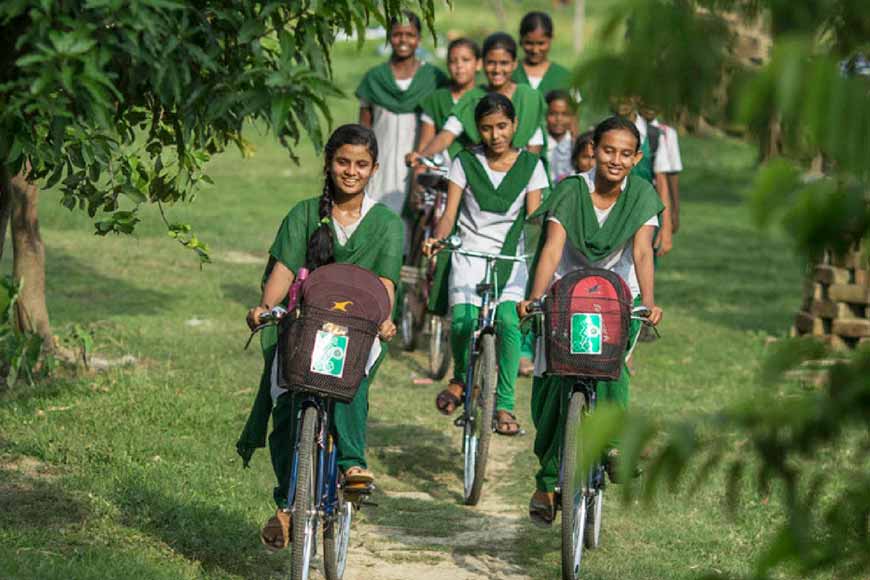Girl students exceed boys in West Bengal

A recent survey released by the Unified District Information System for Education Plus (UDISE+) shows that West Bengal is the only major state in India where girls students have exceeded the number of boys. Only three other states --- Arunachal Pradesh, Assam and Meghalaya have enrolled more girl students than boys. As per the report released by UDISE+ 18,74,87,792 students enrolled from pre-primary to class XII in the academic session of 2019-20, with 2,32,012 more girls than boys. The number of girl students is 94,89,902, while the number of boy students is 92,57,890.
This is a great landmark for any state in India, where systematically girls have been forced into domestication, and many of them had to opt out from studying being married off. However, Bengal has always shown the path to woman emancipation, from producing the first female graduate, to the first female doctor to innumerable women freedom fighters and academicians since the British rule. The success of West Bengal’s female education has got a further boost due to the proactive West Bengal government and CM Mamata Banerjee’s several initiatives aimed at promoting schemes to empower girls. One such success story is Kanyashree, that even got accolades in the world forum. Nearly 67 lakh girls have been empowered by the West Bengal government through Kanyashree scheme as well as the Sabooj Sathi Bicycle scheme introduced by Hon’ble Chief Minister Mamata Banerjee.
So far as Muslim education is concerned the state shares a better average than the national average. According to the data, 30.5% students have enrolled themselves between pre- primary to Higher Secondary where 32% are girls and 28.9% are boys. The educational schemes of the state government have benefited the minority community as well.
“Girls are the assets of the nation and they make everybody proud,” said Chief Minister Mamata Banerjee on the occasion of the seventh Kanyashree Divas. Kanyashree is a conditional cash transfer scheme aimed at providing incentives to ensure girls stay in school, thereby delaying their marriage till the age of 18 years. The flagship project, launched in 2013, offers two cash transfer components for unmarried girls. The first is an annual scholarship of Rs 1,000 for girls between 13 and 18 years of age, and the second is a one-time grant of 25,000 after they attain the age of 18, provided they are engaged in an academic or occupational pursuit.
While most states in India including the central government have similar projects to educate and empower girls but West Bengal’s success lies in the implementing mechanism. When the other states tried to reach the grass root level through Panchayats, West Bengal is the only state where the Kanyashree has been implemented through administrative mechanisms.
“The Block development offices and SDO s have compelled the parents to enroll their girl child in schools. This social and administrative compulsion has allowed the girl students a better access to school and education” a senior official from the state Women and Child Welfare Department said. People have also understood the importance of female literacy and education. The lower income strata, particularly, the village folk have realized the evil consequences of marrying their daughters off without imparting them basic education. Many young girls are also coming forward. They want to study, be independent and stand by their family and be the bread earner.
The success of West Bengal’s female education has got a further boost due to the proactive West Bengal government and CM Mamata Banerjee’s several initiatives aimed at promoting schemes to empower girls. One such success story is Kanyashree, that even got accolades in the world forum.
Interestingly, it has been observed that the number of dropouts in case of boys are higher than girls. The boys are required to work from a very young age. The state has not only fared better in respect to the national average, but the girl students have excelled than the boy students. Some data will show the success. In the primary section between class I to class IV the dropout rate is 1.5% overall, in West Bengal the dropout rate is only 0.6%. Surprisingly in the upper primary section that is between the class V to class VII the dropout rate in the state is nil in comparison to national dropout rate which is as high as 2.6%. When in the secondary level the dropout rate is as high as 16.1% in the country, in West Bengal, it is 13.8.
So far as Muslim education is concerned the state shares a better average than the national average. According to the data, 30.5% students have enrolled themselves between pre- primary to Higher Secondary where 32% are girls and 28.9% are boys. The educational schemes of the state government have benefited the minority community as well. In 2019-20 an overall 30.9% minority students enrolled themselves in different state education facilities of which 32.4% are girls and 29.4 % are boys. This is much better than the progress rate at the national level.
Following the footsteps of Ishwar Chandra Vidyasagar who worked endlessly to provide equal education to all men and women irrespective of their caste, religion and gender, West Bengal government truly understands and tries to turns his dreams true. With changes, schemes and upliftment in female education, Bengal is all headed for a new Renaissance.










